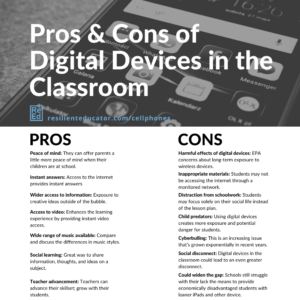
Debating the Use of Digital Devices in the Classroom
While many parents allow children free reign of the internet at home, it’s a common debate in education circles on how—and if—digital devices should be allowed at school.
Supporters of technology in the classroom say that using laptops, tablets, and cellphones in the classroom can keep students engaged. Technology is what they know. Most students today don’t even remember a time without the internet.
But critics say it’s yet another distraction in the classroom. From social media to texting, allowing digital devices could hinder a student’s performance in the classroom.
Read on to discover the main arguments surrounding the global debate on digital devices and their place in our schools.
Pros of digital devices in the classroom
- Peace of mind: Cellphones and smartphones can offer parents a little more peace of mind when their children are at school. Parents know that in an emergency the student can contact them, or vice versa. In addition, more and more cellphones and smartphones contain GPS devices that can be tracked if necessary.
- Instant answers: Access to the internet provides instant answers for the curious. This is the search-and-learn environment kids are involved in today. Now, when they want to know “Why do leaves change color,” they are only a search away from an answer. This also gives students the ability to get an answer to a question they may feel uncomfortable asking in class. If a teacher uses a term they don’t understand, they can find the answer discretely, and without interrupting the class.
- Wider access to information: With internet access, children can be exposed to a world of creative ideas outside of their bubble. They can learn other languages, teach themselves how to draw, knit, or play chess. They have access to an endless array of options available to help them learn, and gain skills they might not otherwise be exposed to. All of this can be accomplished through a smartphone, which can be a valuable learning tool, if used correctly.
- Access to video: Electronic devices in the classroom can enhance the learning experience by providing instant video access. Martin Luther King’s “I Have a Dream” speech is not just something to read about. Man’s first step on the moon, early flight, presidential speeches, bridges being built—they all are made more real and easier to digest in the form of instant video availability.
- Wide range of music available: Sure, you might think of kids listening to their pop, hip-hop, and rap music on digital devices, but remember that all music is available. This gives students access to classical, jazz, big band, and early rock ‘n’ roll. Students could have the opportunity to compare and discuss the differences in these styles in a way that is familiar to them.
- Social learning: Social media can have a negative connotation when you link it to kids. However, there can be an educational aspect. Social learning is a great way for students to share information, thoughts, and ideas on a subject. Properly focused, quieter, and shyer students may blossom in a social learning situation made possible by digital devices.
- Teacher advancement: Finding ways to effectively utilize digital devices in the classroom provides teachers with an opportunity to advance their skillset and grow with their students. Many teachers are taking their digital literacy to the next level by earning an master’s degree in education technology.
Cons of digital devices in the classroom
- Harmful effects of digital devices: There are concerns from the EPA about long-term exposure to wireless devices and computer screens. While there is no direct evidence of harmful effects, the EPA discourages too much exposure for students who have video screens in front of their faces or computers in their laps. If students frequently use these devices at home, additional exposure at school could be viewed as harmful.
- Inappropriate materials: While schools can limit the availability of websites that can be viewed on their network, students may find links that slipped through the system. There will also be times that students will not be accessing the internet through a monitored network.
- Distraction from schoolwork: With the temptation of social media and texting in their hands, students may focus solely on their social life instead of the lesson plan.
- Child predators: Child predators are a problem everywhere. Using digital devices at school creates just that much more exposure and potential danger for students.
- Cyberbulling: This is an increasing issue that’s grown exponentially in recent years. Permitting use of digital devices in the classroom could potentially lead to more of it.
- Provide a disconnect: While some believe digital devices make for greater connections for students, there are also those who believe too much time with digital devices disconnects students from face-to-face social activities, family communications, and nature. Digital devices in the classroom could lead to an even greater disconnect.
- Could widen the gap: Technology spending varies greatly across the nation. Some schools have the means to address the digital divide so that all of their students have access to technology and can improve their technological skills. Meanwhile, other schools still struggle with their computer-to-student ratio and/or lack the means to provide economically disadvantaged students with loaner iPads and other devices so that they can have access to the same tools and resources that their classmates have at school and at home.
Should schools permit digital devices?
Some school districts have seen great improvements by allowing digital devices in the classroom. One thing is clear: if digital devices are permitted, there should be guidelines and rules in place.
Students need to be taught online safety, the use of judgment in determining good quality sources of information, and restraint from personal use in the classroom. In other words, they need to learn all about digital literacy and digital citizenship.
There are many resources for teaching these concepts, and a great place to start is the International Society for Technology in Education (ISTE). Their comprehensive standards focus on the skills and qualities students should have in order to be successful in the digital world. ISTE also teamed up with Google and developed an online digital citizenship game called Interland. It educates kids about digital citizenship in interactive ways. Students learn how to be good digital citizens as well as how to combat hackers, phishers, oversharers, and bullies.
If a school is going to allow and/or encourage the use of digital devices in the classroom, then teachers also need proper support in terms of training, professional development, and curriculum. They can start with curriculum and PD resources such as those provided by Common Sense Media, but in order to fully utilize them, teachers need time to plan and collaborate. Digital devices should only be used when there are specific goals in mind, focusing on student safety, digital citizenship, critical thinking, collaboration, advancement, and equity.
Categorized as: Tips for Teachers and Classroom Resources
Tagged as: Educational Technology, Educational Technology Leadership, Social Media

